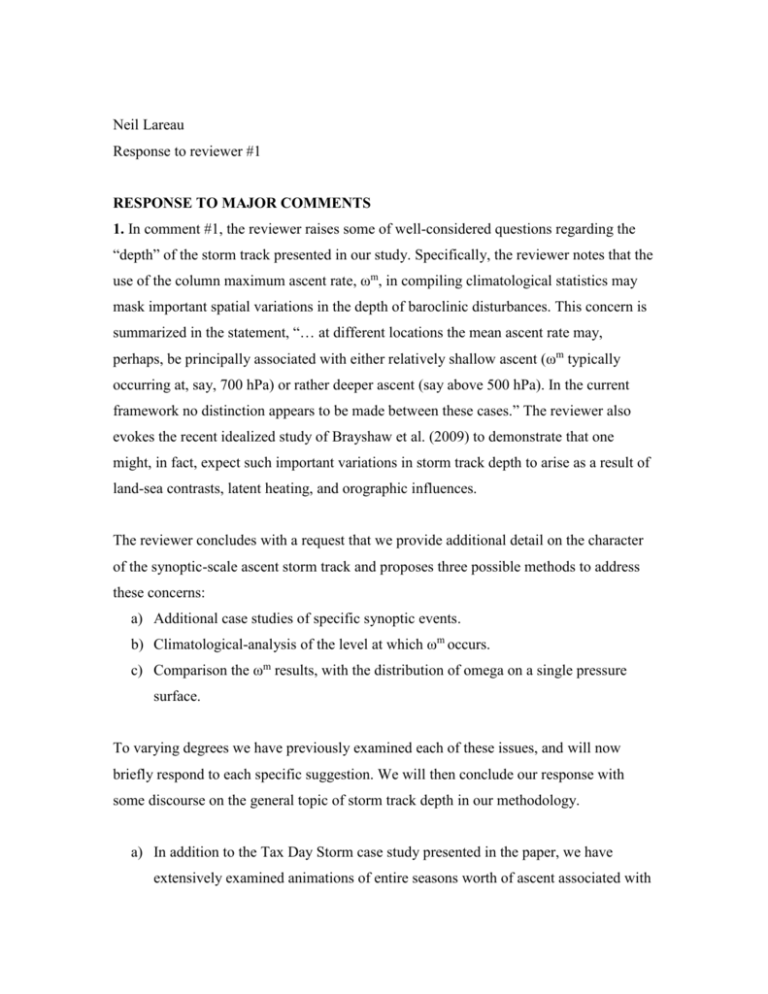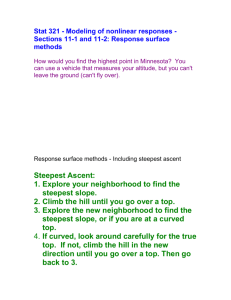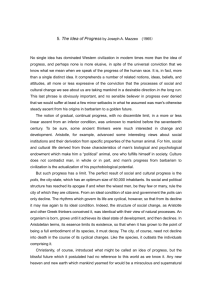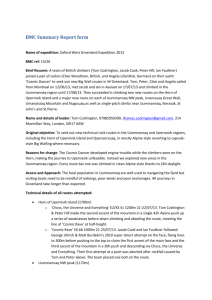NPL_MWRR_1
advertisement

Neil Lareau Response to reviewer #1 RESPONSE TO MAJOR COMMENTS 1. In comment #1, the reviewer raises some of well-considered questions regarding the “depth” of the storm track presented in our study. Specifically, the reviewer notes that the use of the column maximum ascent rate, ωm, in compiling climatological statistics may mask important spatial variations in the depth of baroclinic disturbances. This concern is summarized in the statement, “… at different locations the mean ascent rate may, perhaps, be principally associated with either relatively shallow ascent (ωm typically occurring at, say, 700 hPa) or rather deeper ascent (say above 500 hPa). In the current framework no distinction appears to be made between these cases.” The reviewer also evokes the recent idealized study of Brayshaw et al. (2009) to demonstrate that one might, in fact, expect such important variations in storm track depth to arise as a result of land-sea contrasts, latent heating, and orographic influences. The reviewer concludes with a request that we provide additional detail on the character of the synoptic-scale ascent storm track and proposes three possible methods to address these concerns: a) Additional case studies of specific synoptic events. b) Climatological-analysis of the level at which ωm occurs. c) Comparison the ωm results, with the distribution of omega on a single pressure surface. To varying degrees we have previously examined each of these issues, and will now briefly respond to each specific suggestion. We will then conclude our response with some discourse on the general topic of storm track depth in our methodology. a) In addition to the Tax Day Storm case study presented in the paper, we have extensively examined animations of entire seasons worth of ascent associated with transient baroclinic disturbances. The level of maximum ascent varies slightly from one storm to the next, within the life cycle of a given storm, and spatially within each event (e.g. the Tax Day Storm in our Figs. 2 and 3). This was, in fact, the original motivation for using a freely varying level of maximum ascent. Rather than confining our climatology to an arbitrary level, we thought it more representative to allow for changes in the pressure level of the strongest ascent to account for a range of possible storm configurations. However, we do not observe notable departures from the general rule of thumb that synoptic-scale ascent is at a maximum in the mid-troposphere (Durran and Snellman 1987). b) Figure 1 of this response presents an analysis of the climatological pressure level of maximum ascent. The results are rather bland, with ascent almost always dominated by that at either 500 or 400 hPa. Only two grid points experience their greatest climatological mean ascent at 600 hPa, and none at other levels. Also shown in Fig. 1 is the regional topography (from the ERA-interim), which suggests that ascent tends to maximize at a lower pressure (400 hPa) over the lee slopes of the Rocky Mountains. We do not have a clear dynamical interpretation of this result. However, these results are generally consistent with the tendency for omega throughout the column to be dominated by forcing aloft, insensitive to low level forcing, and maximized in the mid-troposphere (Durran and Snellman 1987; Clough et al. 1996).That omega tends to maximize in the mid-troposphere is in part a result of the imposition of zero omega conditions at the upper and lower boundaries in the integration of our Equation 3. We choose to not include this additional figure in the updated manuscript because we believe it adds little value to the interpretation of the results. We have, however, included two additional lines in the text to address this point. The first appears in the methods section and emphasizes the findings of Durran and Snellman (1987) and Clough et al. (1996) that are described above (see new text at lines 173-177). The second, in the climatological results portion of the paper (lines 342-345), states that , “The climatological pressure level of maximum ascent corresponding with the values in Figs. 4 and 5 is most everywhere found at 500 hPa, except over the lee slopes of the Rocky Mountains and south of about 28 °N where it has a tendency to occur at 400 hPa (not shown).” c) For the reasons addressed above, comparing ascent at 500 or 400 hPa with the climatology presented in the paper yields nearly identical qualitative results. The ascent storm track at lower and higher levels is still generally similar in structure, but much diminished in magnitude. There is some suggestion that the local maximum in ascent over Oklahoma is comparatively larger when looking just at 700 hPa, suggesting a deeper column of strong ascent may relate to developing lee cyclones found downstream from the Rocky Mountains. Another reviewer requested some additional discourse about this lee side maximum, and we have added a line to the paper (lines 326-328) stating, “This tertiary maximum is less well associated with the mid-tropospheric geopotential, and is likely related to developing cyclones in the lee of the Rocky Mountains (Hobbs et al. 2000). ” Now we offer some more general comments on this topic. As briefly discussed above, Durran and Snellman (1987) and Clough et al. (1996) demonstrate that the omega “response”, which is to say the three dimensional distribution of omega, is dominated by long wave “forcing” for ascent at upper levels and is relatively insensitive of short wave features at lower levels. As such the current methodology in our study precludes a direct assessment of the comparative forcing at different levels because the total omega field results from the superposition of all forcing. Thus, without considerable additional computation we have a limited capacity to examine the comparative contributions to ascent occurring at different levels. In fact, upper level processes will nearly always dominate the response at any level (Deveson et al. 2002). Furthermore, to avoid topographic complexity we have deliberately restricted our analysis to levels above 850 hPa (and in fact the response is required to be zero at that level), which makes it impossible to examine the role of low altitude forcing for ascent such as the 925 hPa baroclinicity shown in Brayshaw et al. 2009. The reviewer wonders to what extent our storm track represents these shallow disturbances, the answer to which is, “not at all,” because we have no atmosphere below 850 hPa. However, it would be possible in future investigations to directly examine the climatological distribution of forcing for ascent at different levels. Following the omega “attribution” technique of Deveson et al. (2002; which itself follows from Clough et al. 1996), we would be able to compare the omega response to forcing below some level, say 700 hPa, with that arising from upper level forcing. The ratio of these quantities at the intermediate level can then be used to classify the dynamical forcing mechanisms for a given storm or the climatological propensity for different types of development (Devenson et al., 2002; Gray and Dacre 2006, Dacre and Gray 2009). This approach is beyond the scope of the current paper, but will likely be included in subsequent investigations, which are now underway and employ improved computational techniques enabling more flexible investigations. The reviewer also ponders the application of our current technique across a broader geographic domain. This too is underway for the entire global distribution of storms, and in combination with the Devenson et al. (2002) attribution technique may provide insight into the reviewer’s question about changes in storm depth across continental margins and in the presence of greater latent heating. However, we do not feel that the current study is the best venue to answer these questions because the study domain does not include the east coast of the United States where such processes are surmised to be of great importance (Brayshaw et al. 2009). 2. In the second major comment the reviewer asks how much of the ascent pattern shown in Figs. 4 and 5 is associated with the time mean flow versus transient synoptic-scale systems. In reviewing countless animations of ascent accompanying synoptic disturbances it is clear that our entire climatological ascent pattern is due to synopticscale transients. However, it is not clear to us that the time mean flow is somehow separate from these transient disturbances, but rather has the additive effect of all such disturbances incorporated into it. In other words the time mean flow is not the spatial and temporally filtered low frequency component of the circulation but rather the superposition of the flow at all scales. Because ascent in the mid-latitudes during winter is dominated by the baroclinic contribution we would expect that the majority of the “mean-flow ascent” is simply the result of the high frequency baroclinic disturbances. Using band-bass filtering, such as Blackmon et al. (1976), might be a better method to address the contribution of the low frequency components of the flow. However, our current work deliberately examines only “storms.” We nonetheless find the Brayshaw et al. 2009 pattern of ascent anomalies in the mean flow proximal to the idealized Rocky Mountains (their Fig. 15), quite interesting. We have added a reference to the Brayshaw et al (2009) study as well as the following text to our manuscript (lines 328-331): “The general northeasterly orientation and intensification of the downstream storm track may also arise due to the impact of the Rocky Mountains on jet stream orientation, mean-flow ascent anomalies, and near surface baroclinicity (Brayshaw et al. 2009).” RESPONSE TO MINOR COMMENTS 1. We have added State abbreviations to our Fig. 1 to improve interpretation for readers outside of North America. For visual simplicity we neglect these labels form all subsequent figures. 2. We have fixed the figure references in section 4b. REFERENCES Blackmon, M. L., 1976: A climatological spectral study of the 500 mb geopotential height of the Northern Hemisphere. J. Atmos. Sci., 33, 1607–1623. Brayshaw, D. J., B. J. Hoskins, M. Blackburn, 2009: The basic ingredients of the North Atlantic storm track Part I: Land-sea contrast and orography. J. Atmos. Sci., 66, 2359-2558. Clough, S. A., C. S. A. Davitt, and A.J. Thorpe, 1996: Attribution concepts applied to the omega equation. Quart. J. Roy. Meteor. Soc., 122, 1943–1962. Dacre, H. F., and S. L. Gray, 2009: The spatial distribution and evolution characteristics of North Atlantic cyclones. Mon. Wea. Rev.., 137 99–115. Deveson, A. C. L., K. A. Browning, and T.D. Heweson, 2002: A classification of FASTEX cyclones using a height-attributable quasi-geostrophic vertical-motion diagnostic. Quart. J. Roy. Meteor. Soc., 128, 93117. Durran, D. R., and L. W. Snellman, 1987: The diagnosis of synoptic-scale vertical motion in an operational environment. Wea. Forecasting, 2, 17–31. Gray, S.L., and H.F. Dacre, 2006: Classifying dynamical forcing mechanisms using a climatology of extratropical cyclones. Quart. J. Roy. Meteor. Soc., 132, 1119-1137. Figure 1. Climatological mean pressure level of maximum ascent (shading) and regional topography (contours, interval 500 m).






